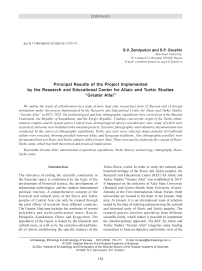Principal results of the project implemented by the Research and Educational Center for Altaic and Turkic Studies “Greater Altai”
Автор: Zemlyukov S.V., Grushin S.P.
Журнал: Archaeology, Ethnology & Anthropology of Eurasia @journal-aeae-en
Рубрика: Ethnology
Статья в выпуске: 3 т.52, 2024 года.
Бесплатный доступ
We outline the result of collaboration by a team of more than sixty researchers from 22 Russian and 13 foreign institutions under the project implemented by the Research and Educational Center for Altaic and Turkic Studies “Greater Altai” in 2022–2023. Six archaeological and four ethnographic expeditions were carried out in the Russian Federation, the Republic of Kazakhstan, and the Kyrgyz Republic. Findings concern the origin of the Turkic ethno-cultural complex and its spread across Central Asia. Archaeological surveys revealed new sites, many of which were excavated, and some were included in the museum projects. Extensive photographic and volumetric documentation was conducted. In the course of ethnographic expeditions, Turkic epic texts were collected, many elements of traditional culture were revealed, showing parallels between Altaic and Kyrgyzian traditions. Also ethnographic parallels were documented between Slavic and Turkic cultures of the Greater Altai. These were used to elaborate the concept of Slavo-Turkic unity, which has both theoretical and practical implications.
Короткий адрес: https://sciup.org/145147207
IDR: 145147207 | DOI: 10.17746/1563-0110.2024.52.3.110-117
Текст научной статьи Principal results of the project implemented by the Research and Educational Center for Altaic and Turkic Studies “Greater Altai”
The relevance of uniting the scientific community in the Eurasian space is conditioned by the logic of the development of historical science, the development of information technologies, and the modern international political realities. A comprehensive concept of the historical and cultural unity of the Slavic and Turkic peoples of Central Asia can only be created through the joint efforts of scientists from different countries. The Greater Altai area includes the territories of several polyethnic and multi-confessional states: Russia, Mongolia, Kazakhstan, China, and Kyrgyzstan. The population of the region is linked by the historical and cultural roots, as well as by the centuries-old traditions, all of which conditioning the specific features of the
Turko-Slavic world. In order to study the cultural and historical heritage of the Slavic and Turkic peoples, the Research and Educational Center (REC) for Altaic and Turkic Studies “Greater Altai” was established in 2019. It happened on the initiative of Altai State University (Barnaul) and Gorno-Altaisk State University (Gorno-Altaisk) at the First International Altaic Forum. Both universities are located in the heart of the Greater Altai area. At present, it is an international team of scholars united by the idea of studying and preserving the cultural and historical unity of Slavic and Turkic peoples. The research process involves specialists from different scientific fields, which makes it possible to implement the interdisciplinary approach. The REC for Altaic and Turkic Studies “Greater Altai” integrates many leading researchers to form an objective and holistic view of the
origin and the historical and cultural unity of Slavic and Turkic peoples, as well as to posit Altai as the historical homeland of the latter (Zemlyukov, Grushin, 2021). Some new aspects of the processes of formation and distribution of the Turkic cultural complex, as well as the interaction between Slavic and Turkic peoples in various historical periods, are revealed on the basis of major international interdisciplinary studies, including historical, archaeological, ethnographic, legal, and other reconstructions.
The main objectives of the project “The Turkic-Mongolian World of the Greater Altai” and of the Research and Educational Center (REC) were formulated as follows:
-
1) the establishment of a world-class international research center for Altaic and Turkic Studies on the basis of the REC;
-
2) the creation of a permanent research and educational team of scientists, teachers, postgraduates, and masters from the universities of Central Asian countries on the basis of the REC;
-
3) the development of the concept of Slavo-Turkic unity and its realization in the field of international research and educational cooperation;
-
4) the expansion of research and educational cooperation with the universities of Eurasian countries.
For the first time in modern history, an international team consisting of more than 60 researchers has been assembled within the framework of one research project. The team comprises leading scholars in the field of Turkic Studies from 22 Russian and 13 foreign research and educational centers. It includes scientists from Russia, Kazakhstan, Kyrgyzstan, and Uzbekistan. The REC “Greater Altai” has become a platform for the interaction and partnership between leading universities and research centers of Russia and Central Asian countries. More than 50 universities and research institutions in Eurasia have signed the co-operation agreements.
A qualitative step in the international cooperation was the opening in 2023 of the representative offices of the REC in Uzbekistan and Kyrgyzstan on the basis of Samarkand State University and Kyrgyz National University, respectively. Preparations are currently underway to open a similar center in Kazakhstan. The established system of international co-operation has already demonstrated its efficacy in the scientific, educational, and information spheres. At present, the research work of the REC “Greater Altai” is organized in five project groups headed by leading experts in the field of Altaic and Turkic Studies from the universities and research centers of Central Asian countries. The researchers concentrate their efforts on solving several principal scientific problems.
-
1. The identification of specific features of the formation and distribution of the Turkic ethno-cultural
-
2. The comprehensive analysis of political, legal, and confessional processes in the Turkic world of the Greater Altai area both in historical retrospective and in the modern period.
-
3. The formation of a holistic view of the historical and cultural interaction between Slavic and Turkic peoples, as well as the development of the concept of the Slavo-Turkic unity.
-
4. The assessment of modern perception of the history of Slavo-Turkic relations by Turkic peoples of Central Asia, and the assessment of its reflection in the world information space.
complex in Central Asia on the basis of archaeological, ethnographic, linguistic, and written sources.
In the present article, we will review the main results of the Research and Educational Center activities aimed at identifying the specific features of the formation of the Turkic ethno-cultural complex and its spread in the Greater Altai area. Notably, the historiography on this scientific problem covers several centuries. Among the scientists who made a significant contribution to the development of the topic at the level of monographs are historians, ethnographers, linguists, and archaeologists, such as N.Y. Bichurin (1950), S.E. Malov (1951), A.N. Bernshtam (1952), L.N. Gumilev (1993), N.V. Kyuner (1961), A.A. Gavrilova (1965), L.R. Kyzlasov (1969), V.D. Kubarev (1984), V.I. Molodin (Baraba…, 1988), Y.S. Hudiakov (1991), K.S. Tabaldiev (1996), V.A. Mogilnikov (2002), A.M. Shcherbak (2001), S.G. Klyashtorny, D.G. Savinov (2005), G.V. Kubarev (2005), V.V. Gorbunov, A.A. Tishkin (2022), N.N. Seregin, S.A. Vasyutin (2021), and others. Among the summarizing fundamental publications of recent years, which include sections devoted to the medieval period, we can name “The History of Siberia” (Istoriya Sibiri, 2019: 287–534) and “The History of Altai” (Istoriya Altaya, 2019: 310–353). It is also appropriate to mention here the first volume “The Turkic World in the 6th–12th Centuries AD” of the collective monograph “Chronicle of the Turkic Civilization” (Letopis…, 2023) prepared by an international team of scholars under the project “Greater Altai”. Despite the substantial historiography, many aspects of the Turkic Studies, especially the archaeological aspects, remain underexplored. This research continues the work of our predecessors.
Results of the activity of the REC for Altaic and Turkic Studies “Greater Altai”
The work on the formation of some new archaeological and ethnographic sources was carried out within the framework of the identified research issues. For that purpose, ten international expeditions were undertaken from 2021 to 2023: six archaeological, and four ethnographic. More than 70 scientists, postgraduates, and students from six research and educational institutions of Russia and Kazakhstan took part in the archaeological expeditions. The work was carried out in the Altai Territory, the Altai Republic, and Kazakhstan. During the expeditions, an extensive scientific program was implemented, including the identification of new sites, the photographic and 3D documentation of the structural features of sites, as well as the excavation and museumization of the archaeological sites of pre-Turkic and Turkic times. We shall focus on the main results of the archaeological research of the international expeditions “Greater Altai: the Turkic Heritage”.
Sentelek – 2022–2023. The studies were conducted in the Charyshsky District of the Altai Territory. The excavations of the non-contemporaneous cemeteries of Ust-Teplaya, Urochishche Balchikova-3, and Malaya Tatarka-2 involved researchers from Altai and Kemerovo State Universities, the Institute of the History of Material Culture RAS, and Pavlodar State University of the Republic of Kazakhstan. Some undergraduate, graduate, and postgraduate students from those institutions also took part in the excavations.
The archaeological complex of Ust-Teplaya is located on the above-floodplain left-bank terrace where the Teplaya River flows into the Charysh River, 200 m to the east-northeast of the “Zazubra” Tourist Center. The site was discovered by P.I. Shulga in 1996. In 1999, the researcher recorded eight sites in the form of mounds and stone alignments of various sizes. In 2000, the Research and Development Center “Heritage” and the Barnaul Laboratory of Archaeology and Ethnography of Southern Siberia of the Institute of Archaeology and Ethnography of the Siberian Branch of the Russian Academy of Sciences (IAET SB RAS) and of Altai State University conducted emergency works under the direction of P.I. Shulga. In the course of the works, eight stone mounds were excavated (Grushin, Shulga, Fribus, 2022: 173).
During the international expeditions in 2022–2023, seven stone mounds and two altars were investigated at the site. The identified constructions, features of the burial rite, and the finds made it possible to establish the cultural and chronological affiliation of these objects. The earliest of the studied complexes (three mounds) was attributed to the Afanasyevo culture of the 31st–28th centuries BC (Ibid.). It was represented by small above-ground burial structures of rounded or oval shape, made of flagstone, one of them having a crepidoma made from stone slabs. The buried people were laid in shallow pits on their backs, with their heads to the west and their legs being bent with the knees up. Four excavated mounds were attributed to the Pazyryk culture of the Early Iron Age (6th– 5th centuries BC). The rounded mounds, 6–10 m in diameter, were made of both flagstone and gravel. Burial chambers made of wood or stone slabs were built in the grave pits up to 1.8 m deep. The deceased were laid on their backs with their heads to the south-west. The features of the burial rite included the accompanying burials of horses, secondary burials, and sacrificial food (ram). The grave goods were represented by some ceramic vessels, a bronze dagger in a wooden scabbard, a bronze mirror, some iron knives, and some ornaments (torques, earrings, headdress details, etc.).
The cemetery of Malaya Tatarka-2 is located 7.2 km south-east of Sentelek village, on the left bank of the Charysh River, 200 m north-west of the confluence of the Malaya Tatarka River. The site was discovered by Shulga in 1991. In 2022–2023, three stone mounds were excavated, extended in a chain along the N–S line. The above-ground burial structures included enclosures of flat slabs laid flatwise on top of each other in two or three layers. In the center, there was a burial chamber of rounded shape, made of vertically imbedded stone slabs. The buried people were laid in shallow pits on their backs, with their heads to the west and their legs being bent with the knees up. The grave goods included ceramic vessels and bracelets made of stone and iron beads. The construction features of the mounds, the burial rite, and the finds allowed us to attribute the sites to the Afanasyevo culture of the 32nd–27th centuries BC.
Materials of the Turkic times were obtained during the excavation of burial mounds at the Urochishche Balchikova-3 cemetery, located on the left bank of the Sentelek River on the second above-floodplain terrace, 3.4 km upstream of the Sentelek village (Fig. 1). The site was discovered by Shulga in 1991. In the period from 1991 to 2000, the elite burial mound of the Pazyryk period was partially cleared, nineteen stone stelae were restored to the east of the mound, five medieval mounds were excavated to the north-east of the “royal” one, and four more burial mounds were cleared (Shulga, Demin, 2021).
The works in 2023 were a logical continuation of the excavations of the site carried out earlier. Their aim was to investigate the medieval burial mounds to the northeast of the “royal” mound. Three burial mounds were excavated; two of them turned out to be without burials; the third one was an unlooted burial of a man with a horse and a ram (Fig. 2). Details of the horse equipment were found—cheek-pieces, horse-bits, buckles, and plaques. According to the features of the burial rite and the grave goods, the burial can be attributed to the Turkic times and tentatively dated to the 8th–9th centuries.
Notably, more than 40 burial mounds were recorded at the Urochishche Balchikova-3 cemetery in 2023. Some of the mounds undoubtedly belonged to the Turkic times, as evidenced by the presence of the stelae near the eastern fringes of the mounds. This is the largest Turkic cemetery on the territory of Northern Altai, marking the northern border of the distribution of the ancient Turkic culture and the contacts with the nomads of the Altai steppes.

Fig. 1. The Urochishche Balchikova-3 cemetery (view of the “royal” burial mound and its periphery from the north-west).
We can state that in the Charyshsky District of the Altai Territory there is a large number of burials of various historical periods, from the Chalcolithic to the Early Middle Ages. In this area, there is a necropolis with numerous burials from the Early Turkic period. Further archaeological excavations will make it possible to open new pages in the history of the Turkic peoples of the Greater Altai area. In order to preserve the cultural heritage, including the Turkic one, it is necessary to withdraw the territory of the site from the economic use and to create a cluster such as a “landmark site”.
Kalmakkyrgan – 2022, Semiyarka – 2023. The surveys were carried out in the Maysky and Ust-Kamenogorsky districts of the Pavlodar Region of the Republic of Kazakhstan. There were 25 participants—scientists, undergraduate, graduate, and postgraduate students—from the Margulan Institute of Archaeology, as well as from Altai and Pavlodar State Universities. A total of five sites from the pre-Turkic and Turkic times were studied. Three Turkic funeral enclosures were discovered and studied (Fig. 3), a stone mound of the pre-Turkic time was excavated, and a stone sculpture was discovered (Merts V.K., Merts I.V., Demidkova, 2020). The complex of settlements in the Kalmakkyrgan Mountains was investigated for the first time. The obtained materials will provide reliable data for the reconstruction of the subsistence system of the early medieval nomads. The field data analysis is currently underway.
Ulagan – 2022, Kosh-Agach – 2023. The main task of the
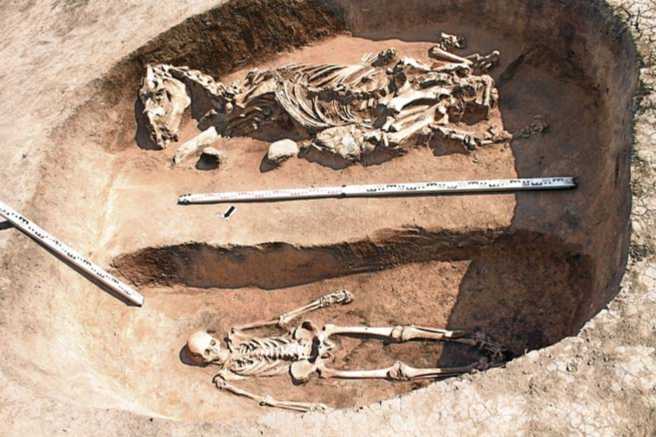
Fig. 2. The burial of a man with a horse at Urochishche Balchikova-3 (taken from the north-west).
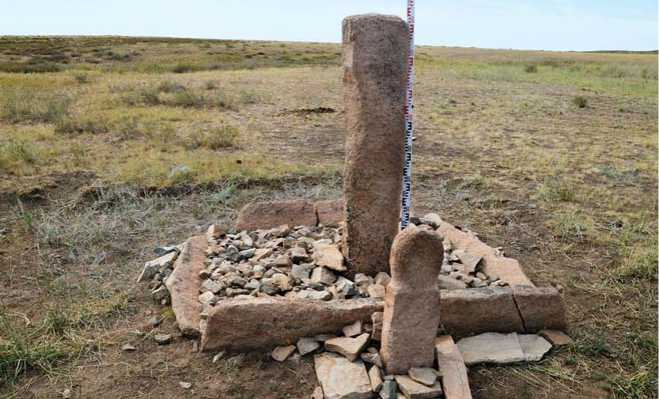
Fig. 3. Turkic funeral enclosure after the reconstruction. Photo by S.P. Grushin .
Виртуальный музей:
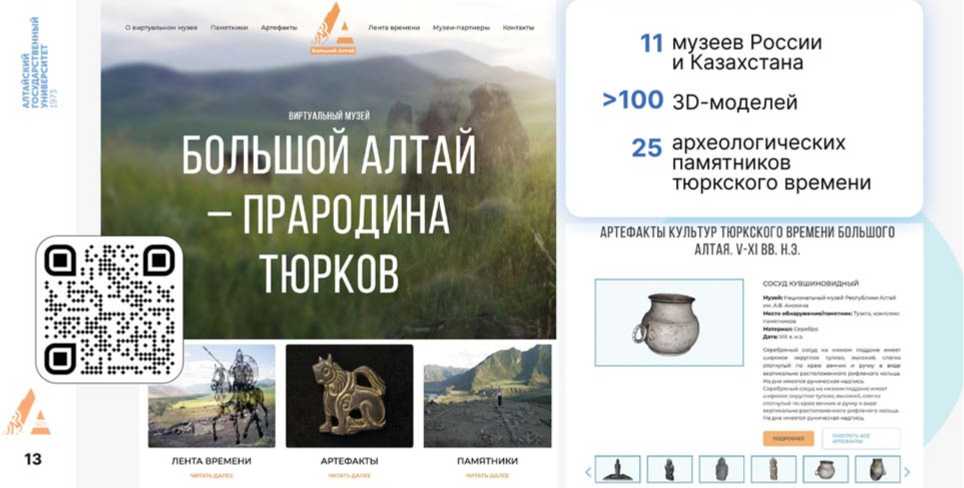
Fig. 4. The virtual museum “Greater Altai—the Ancestral Home of the Turks”.
expeditions was recording and monitoring of the already known archaeological sites of the Turkic times in the Shebalinsky, Ongudaysky, Ulagansky, and Kosh-Agachsky districts of the Altai Republic. The archaeological survey was carried out by researchers from Altai, Kemerovo and Pavlodar State Universities. More than 40 sites were surveyed. The obtained materials were used to create a catalogue of the Turkic archaeological sites in the Altai. The first issue of the catalogue has already been published (Rannesrednevekoviye pamyatniki…, 2022), and the second issue is currently in preparation.
One of the tasks of the research activity of the REC is to create a virtual museum “Greater Altai—the Ancestral Home of the Turks” as a platform uniting the information resources of many institutions that are engaged in the preservation and representation of materials of the Turkic era of the Greater Altai area (Fig. 4). At present, the project includes 11 museums in Russia and Kazakhstan. During the two years of its implementation, over 100 3D-models have been created of the most outstanding exhibits and, importantly, of 25 archaeological sites of the Turkic times. Among the exhibits, there are stone sculptures, items of toreutics, items of armour, details of outfit, ornaments, horse harness, etc. All exhibits are publicly available on the website of the Research and Educational Center “Greater Altai”.
The main section of the virtual museum integrates visual images of the most essential exhibits from the preTurkic and Turkic times. It contains 3D-models of the most impressive and significant objects of art and material culture of the medieval Turks. In addition to the main section, there are other units, presenting information about the archaeological sites of the Turkic times in the Greater Altai, as well as about the ancient and medieval history of the Turks (Frolov, Grushin, 2021).
The new materials obtained and the analysis of the already available archaeological data have confirmed the model of emergence and development of the ritual practice of the early medieval Turks of the Greater Altai. The results of excavations of the memorial and funeral sites demonstrate that the Turkic culture was formed on the basis of two main components: the local one, represented by the complexes of the Bulan-Koba culture of the Xianbei-Rouran time; and the alien one, associated with the population whose earlier history has not yet been provided with any archaeological materials (Tishkin, Seregin, 2011: 28). This is confirmed by the written sources—the Chinese chronicles (Tishin, 2023).
Another research task is to identify the ethnographic parallels between different Turkic peoples of the Greater Altai countries, in particular, to do a comparative study of various aspects of the material and spiritual culture of the Altaians and the Kyrgyz. Such research was carried out in 2021–2023 during four international ethnographic expeditions in the Republic of Altai and Kyrgyzstan. These are the places of residence of the Altai and Kyrgyz peoples, which preserve the main features of the traditional subsistence system (Oktyabrskaya et al., 2022; Nazarov, 2023; and others):
-
1) “Greater Altai: Russia – Kyrgyzstan – 2021”, September 10–28, 2022, in the valley of Lake Issyk Kul;
-
2) “Greater Altai: From Altai to Chong-Alay”, July 2022, in the Chong-Alaysky District of the Osh Region of the Kyrgyz Republic. The participants were 15 scientists from Russia and Kyrgyzstan (Altai State University, Osh State University, and Balasagyn Kyrgyz National University);
-
3) “Greater Altai: Turkic Heritage – 2022”, August 2022, in the Republic of Altai. The participants were 15 researchers from Russia and Kyrgyzstan (Altai State University, Gorno-Altaisk State University, Jamgerchinov Institute of History, Archaeology and Ethnology of the National Academy of Sciences of the Kyrgyz Republic);
-
4) “Greater Altai: From Altai to Chatkal”, July 1–10, 2023, in the Chatkalsky District of the Jalal-Abad Region of the Kyrgyz Republic.
The ethnographic expeditions and processing of the obtained materials have revealed parallels in the cultural phenomena of the compared ethnic groups (Fig. 5). These reflect the ethnogenetic and historical-cultural ties between the Altai and Kyrgyz peoples in ancient time and in the Middle Ages. Common stages in the ethnic history of these peoples, which had had common ancestors in the past, predetermined the presence of a large number of similar aspects in their modern culture. Notably, being ethnogenetic in nature, these aspects were adapted to the specific environmental, social, and cultural settings of different regions where the Altai and Kyrgyz peoples live today: the Altai-Sayan and Tien Shan mountain systems, respectively (Fig. 6). The expedition teams working both in Russia and Kyrgyzstan included the representatives of universities and research institutions from both countries, which ensured the effectiveness of the research
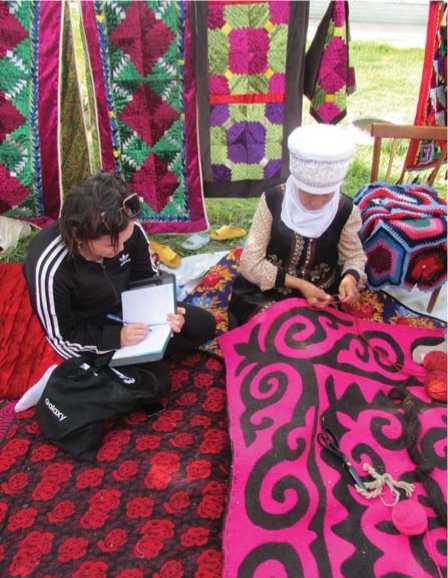
Fig. 5. Kyrgyz craftswoman making a shyrdak felt carpet. The Chatkalsky District of the Jalal-Abad Region of the Kyrgyz Republic. Photo by I.I. Nazarov .
in identifying the similarities and specific features of the compared cultures.
In 2021–2023, within the framework of the research area “Ethnography and Cultural Studies of the Greater Altai”, the ethnographic parallels between the Slavic and Turkic peoples of the Greater Altai countries were

Fig. 6. A summer camp of Kyrgyz cattle breeders ( jailoo ) in the Chong-Alaysky District of the Osh Region of the Kyrgyz Republic. Photo by I.I. Nazarov .
revealed, the material on the Turkic epic was collected, and the contextual analysis of Turkic lexical items was carried out on the basis of the epistolary heritage of the Altai Ecclesiastical Mission of the mid 19th to early 20th centuries. It has been proved that the key factors of the integration of Turkic and Slavic peoples are sacral values, which allow the identification of not only ethno-national cultural features of these peoples, but also substantive (common views, ideas, and traditions) and civilizational (common grounds for building and strengthening the world order) features. The ethnographic research of the REC includes projects aimed at studying Turkic vocabulary. More than 955 word forms of the appellative lexicon of the Turkic origin have been detected in the course of the works. The models involved in formation of these words have been identified (Dmitrieva, Sorokina, Titova, 2023). The study of the epic heritage of Slavic and Turkic peoples of Central Asia is aimed at identifying spiritual constants and cultural archetypes. In the study of the general and local aspects in the epic, the ideological-axiological approach has been applied, which has made it possible to analyze the initial universal spiritual archetypes in the epic texts and the worldview models.
Conclusions
The result of the multidisciplinary study carried out by the international project teams of the REC was the publication of the first volume “The Turkic World in the 6th– 12th Centuries AD” of the monograph “Chronicle of the Turkic Civilization” (Letopis…, 2023). The authors of the project tried to embody a holistic picture reflecting all the historical stages and civilizational forms of coexistence of Slavic and Turkic peoples of Russia and Central Asian countries in the concept of their historical and cultural unity. This is a theoretically substantiated system of sociocultural and worldview values and practices based on the historical and civilizational heritage of these peoples. It relies on their common history, taking into account the experience of co-habitation, the inter-ethnic interaction, and being part of the Turkic, Mongolian and Slavic state formations, namely the Turkic Khaganates, the Golden Horde, the Russian Empire, the USSR, and the CIS.
The concept has important theoretical and practical relevance. The millennial Turko-Slavic interaction is the foundation for integration between Russia and the countries of the Central Asia region, which is based on the ethnogenetic, historical, territorial, state-legal, and cultural backgrounds, and allows achieving greater results with lower social costs. The Slavo-Turkic unity is the main conceptual core of the integration and of its future development and strengthening. This is a Slavo-Turkic, Christian-Muslim, and socially unifying geopolitical project of the Eurasian Union. The fundamental principles of the concept are also relevant for strengthening the Russian state system, implying the Slavo-Turkic unity within the Russian Federation.
Under the assignment of the Ministry of Science and Higher Education of the Russian Federation, the Program of Development of the Research and Educational Center for Altaic and Turkic Studies “Greater Altai” for the years 2023–2030 has been developed, presenting the project of promoting the concept in question as an instrument of the Russian influence on the research and educational space of the Central Asian countries.
Acknowledgement
This study was carried out under Project No. 748715 F.99.1.BB97AA00002 “The Turkic-Mongolian World of the ‘Greater Altai’: Unity and Diversity in History and Modernity”.

